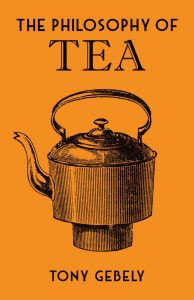 This is part of a series of “Philosophy Of” books. I had trouble finding much on the ‘series’, but it looks like each (or most) was written by a different blogger or other influencer/social media presence. I mostly ended up poking around Brian Williams (the author of Philosophy of Coffee)’s blog trying to get a bit more info on the series’ inception.
This is part of a series of “Philosophy Of” books. I had trouble finding much on the ‘series’, but it looks like each (or most) was written by a different blogger or other influencer/social media presence. I mostly ended up poking around Brian Williams (the author of Philosophy of Coffee)’s blog trying to get a bit more info on the series’ inception.
Gebely’s well known for his other book, Tea: A User’s Guide. It’s a book I own and have read, but not quite cover-to-cover, and haven’t made a post about here quite yet.
I brought this with me camping, along with How to Make Tea, and read them back to back. I think that really helped highlight the problems I had with How to Make Tea, and what I really liked about this book.
For those who have his other book, I’d say not to expect the same sort of depth–only because both were clearly written for different audiences. This is meant to be a sort of ‘introduction’ to go along with the others in the series, but Gebely still lends his own sort of depth to the topic. Still, it breezes over topics and doesn’t make as many distinctions as he does in is other work, but it serves the purpose it was made for, and doesn’t mislead.
There aren’t many diagrams–it’s missing the classic tea type comparison chart–and instead uses a lot of old scans from a variety of sources, from old British tea adverts, production manuals, Chinese tea works, and photos. It probably could have benefited from a few more straight diagrams, but that might have bulked it out a bit too much.
The book is upfront and straightforward with citing sources, which is always refreshing, so there’s none of the usual word-of-mouth incorrect wife’s tales, and as always I enjoy peeking into the bibliography (‘Notes’ and cited Illustrations) to inspire new reading material.
The book is largely broken into two sections: The first details each major category of tea (with examples), while the second details some of the most commonly encountered tea cultures, by country. These are followed by smaller sections on brewing tea and tea health, and these stuck out the most to me after reading How to Make Tea.
Preparing Tea takes a pretty different approach from most books. Instead of detailing all of the different styles and cultures of tea preparation, Gebely basically just covers the variables can control (water ratio, temperature, brew time), the theory behind varying them (a great inclusion), and the rough idea of what teas like what parametres. I think the only thing that made me ‘hm’ was “increase steep time” as an answer to too-weak of tea. Not because it was necessarily wrong, but because most “introduction to making tea” type guides always advise to increase the tea leaf instead, and not to touch the time, as it’ll more often produce bitter, but not flavourful tea.
Tea and Health is the very last chapter–exactly where it should be, honestly–and opens with many words of caution about the veracity of health claims; it’s appropriately carried throughout the section. It’s less than five pages long, and simply details a few recent, cited studies. Including the drawbacks and further considerations for the studies.
For what it is, it’s a great little book… The kind of gifty item that’s worth picking up for someone starting out, who doesn’t need or doesn’t want an in-depth manual, but likes picking up new facts.
- Easy to find under $10 second-hand.




Leave a Reply
You must be logged in to post a comment.